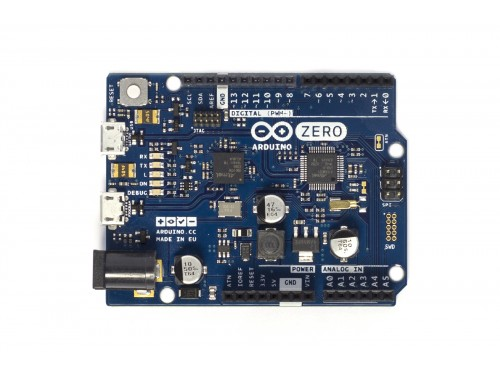Arduino Boards

The number of Arduino boards have increased over the years; some have been discontinued while others are still available. The choice of which board to use depends on several factors: price, features, availability, ease of use, etc. Here’s a summary of all Arduino boards with their pros and cons.
Arduino UNO

Pros: Often the starting board for those new to the Arduino platform as it has all the bare essentials for microcontroller-based projects. It’s cheap but you can go cheaper as it’s the most cloned Arduino board. It is also fairly easy to use and set up.
Cons: Limited features; no IoT capabilities; limited number of pinouts.
Price: $22
Specs:
| Microcontroller | ATmega328P |
| Operating Voltage | 5V |
| Input Voltage (recommended) | 7-12V |
| Input Voltage (limit) | 6-20V |
| Digital I/O Pins | 14 (of which 6 provide PWM output) |
| PWM Digital I/O Pins | 6 |
| Analog Input Pins | 6 |
| DC Current per I/O Pin | 20 mA |
| DC Current for 3.3V Pin | 50 mA |
| Flash Memory | 32 KB (ATmega328P) of which 0.5 KB used by bootloader |
| SRAM | 2 KB (ATmega328P) |
| EEPROM | 1 KB (ATmega328P) |
| Clock Speed | 16 MHz |
| LED_BUILTIN | 13 |
| Length | 68.6 mm |
| Width | 53.4 mm |
| Weight | 25 g |
Arduino Leonardo

Pros: About the same size as the Arduino UNO but has more digital and analog pins. This board comes with a microUSB port instead of a USB Type C port. It also uses only one ATMega microcontroller which makes it a bit cheaper than the UNO.
Cons: Limited features; no IoT capabilities.
Price: $20
Specs:
| Microcontroller | ATmega32u4 |
| Operating Voltage | 5V |
| Input Voltage (Recommended) | 7-12V |
| Input Voltage (limits) | 6-20V |
| Digital I/O Pins | 20 |
| PWM Channels | 7 |
| Analog Input Channels | 12 |
| DC Current per I/O Pin | 40 mA |
| DC Current for 3.3V Pin | 50 mA |
| Flash Memory | 32 KB (ATmega32u4) of which 4 KB used by bootloader |
| SRAM | 2.5 KB (ATmega32u4) |
| EEPROM | 1 KB (ATmega32u4) |
| Clock Speed | 16 MHz |
| Length | 68.6 mm |
| Width | 53.3 mm |
| Weight | 20 g |
Arduino 101

Pros: An Intel-powered version of the UNO with added Bluetooth connectivity and built-in accelerometer and gyroscope.
Cons: Limited number of pinouts.
Price: $30
Specs:
| Microcontroller | Intel Curie |
| Operating Voltage | 3.3V (5V tolerant I/O) |
| Input Voltage (recommended) | 7-12V |
| Input Voltage (limit) | 7-17V |
| Digital I/O Pins | 14 (of which 4 provide PWM output) |
| PWM Digital I/O Pins | 4 |
| Analog Input Pins | 6 |
| DC Current per I/O Pin | 20 mA |
| Flash Memory | 196 kB |
| SRAM | 24 kB |
| Clock Speed | 32MHz |
| LED_BUILTIN | 13 |
| Features | Bluetooth LE, 6-axis accelerometer/gyro |
| Length | 68.6 mm |
| Width | 53.4 mm |
| Weight | 34 gr. |
Arduino Nano

Pros: Technically the same as the Arduino UNO but smaller and can be mounted on a standard breadboard.
Cons: Limited features; no IoT capabilities; limited pinouts; no DC power jack.
Price: $22
Specs:
| Microcontroller | ATmega328 |
| Architecture | AVR |
| Operating Voltage | 5 V |
| Flash Memory | 32 KB of which 2 KB used by bootloader |
| SRAM | 2 KB |
| Clock Speed | 16 MHz |
| Analog IN Pins | 8 |
| EEPROM | 1 KB |
| DC Current per I/O Pins | 40 mA (I/O Pins) |
| Input Voltage | 7-12 V |
| Digital I/O Pins | 22 (6 of which are PWM) |
| PWM Output | 6 |
| Power Consumption | 19 mA |
| PCB Size | 18 x 45 mm |
| Weight | 7 g |
| Product Code | A000005 |
Arduino Micro

Pros: The smallest Arduino board and technically the same as the Arduino Leonardo. Just like the Arduino Nano, this board fits on a breadboard. Also since it uses the same microcontroller as the Leonardo, it has more digital and analog pins than the Pro Mini.
Cons: Limited features; no IoT capabilities; no DC power jack.
Price: $20
Specs:
| Microcontroller | ATmega32u4 |
| Operating Voltage | 5V |
| Digital I/O Pins | 20 |
| PWM Channels | 7 |
| Analog Input Channels | 12 |
| DC Current per I/O Pin | 40 mA |
| DC Current for 3.3V Pin | 50 mA |
| Flash Memory | 32 KB (ATmega32u4) of which 4 KB used by bootloader |
| SRAM | 2.5 KB (ATmega32u4) |
| EEPROM | 1 KB (ATmega32u4) |
| Clock Speed | 16 MHz |
| Length | 48.0 mm |
| Width | 17.7 mm |
Arduino Mega2560

Pros: This is the Arduino board to choose if you want more pins! Besides the 54 digital pins and 16 analog pins, it also has 4 UART terminals. It is also the most used board for robotics because of its 16 PWM outputs (not to mention it has eight times the program space size of the UNO)
Cons: No IoT capabilities. A bit pricey (although there are a lot of cheaper Chinese clones)
Price: $38.50
Specs:
| Microcontroller | ATmega2560 |
| Operating Voltage | 5V |
| Input Voltage (recommended) | 7-12V |
| Input Voltage (limit) | 6-20V |
| Digital I/O Pins | 54 (of which 15 provide PWM output) |
| Analog Input Pins | 16 |
| DC Current per I/O Pin | 20 mA |
| DC Current for 3.3V Pin | 50 mA |
| Flash Memory | 256 KB of which 8 KB used by bootloader |
| SRAM | 8 KB |
| EEPROM | 4 KB |
| Clock Speed | 16 MHz |
| LED_BUILTIN | 13 |
| Length | 101.52 mm |
| Width | 53.3 mm |
| Weight | 37 g |
Arduino Due

Pros: This is powered by a 32-bit ARM microcontroller which makes it almost six times as fast and twice the program memory space as the similarly designed Arduino Mega. Surprisingly, it’s a bit cheaper than the Mega.
Cons: All pins use 3.3V which limits the compatible modules and shields; no IoT capabilities.
Price: $37.40
Specs:
| Microcontroller | AT91SAM3X8E |
| Operating Voltage | 3.3V |
| Input Voltage (recommended) | 7-12V |
| Input Voltage (limits) | 6-16V |
| Digital I/O Pins | 54 (of which 12 provide PWM output) |
| Analog Input Pins | 12 |
| Analog Output Pins | 2 (DAC) |
| Total DC Output Current on all I/O lines | 130 mA |
| DC Current for 3.3V Pin | 800 mA |
| DC Current for 5V Pin | 800 mA |
| Flash Memory | 512 KB all available for the user applications |
| SRAM | 96 KB (two banks: 64KB and 32KB) |
| Clock Speed | 84 MHz |
| Length | 101.52 mm |
| Width | 53.3 mm |
| Weight | 36 g |
Arduino Zero

Pros: If the Due is the 32-bit ARM version of the Mega, then this board is the 32-bit ARM version of the UNO.
Cons: All pins use 3.3V which limits the compatible modules and shields; no IoT capabilities.
Price: $42.90
Specs:
| Microcontroller | ATSAMD21G18, 32-Bit ARM Cortex M0+ |
| Operating Voltage | 3.3V |
| Digital I/O Pins | 20 |
| PWM Pins | All but pins 2 and 7 |
| UART | 2 (Native and Programming) |
| Analog Input Pins | 6, 12-bit ADC channels |
| Analog Output Pins | 1, 10-bit DAC |
| External Interrupts | All pins except pin 4 |
| DC Current per I/O Pin | 7 mA |
| Flash Memory | 256 KB |
| SRAM | 32 KB |
| EEPROM | None. See documentation |
| LED_BUILTIN | 13 |
| Clock Speed | 48 MHz |
| Lenght | 68 mm |
| Width | 30 mm |
| Weight | 12 gr. |
Arduino Yun

Pros: Containing both a microprocessor and a microcontroller, this board can run a Linux distro named Linino. But the most distinctive feature of the Yun is its Ethernet and WiFi connectivity.
Cons: Limited number of ports; Some reported WiFi connectivity issues. Pricey.
Price: $74.95
Microcontroller Specs:
| Microcontroller | ATmega32U4 |
| Operating Voltage | 5V |
| Input Voltage | 5 V |
| Digital I/O Pins | 20 |
| PWM Output | 7 |
| Analog I/O Pins | 12 |
| DC Current per I/O Pin | 40 mA on I/O Pins; 50 mA on 3,3 Pin |
| Flash Memory | 32 KB (of which 4 KB used by bootloader) |
| SRAM | 2.5 KB |
| EEPROM | 1 KB |
| Clock Speed | 16 MHz |
Microprocessor Specs:
| Processor | Atheros AR9331 |
| Architecture | MIPS |
| Operating Voltage | 3.3V |
| Ethernet | 802.3 10/100Mbit/s |
| WiFi | 802.11b/g/n 2.4 GHz |
| USB Type | 2.0 Host |
| Card Reader | Micro-SD |
| RAM | 64 MB DDR2 |
| Flash Memory | 16 MB |
| SRAM | 2.5 KB |
| EEPROM | 1 KB |
| Clock Speed | 400 MHz |
Arduino Tian

Pros: This board is an improved version of the Yun. The added Bluetooth connectivity allows for more IoT-based projects.
Cons: Pricey.
Price: $95.70
General Specs:
| Input Voltage | 5 V |
| PWM Output | 12 |
| Power Consumption | 470 mA |
| PCB Size | 53 x 68.5 mm |
| Bluetooth | CSR8510, Bluetooth with EDR / BLE 4.0 |
| Weight | 36g |
| Product Code | A000116 |
Microcontroller Specs:
| Microcontroller | SAMD21G18 |
| Architecture | ARM Cortex-M0+ |
| Operating Voltage | 3.3V |
| Flash Memory | 256 KB |
| SRAM | 32 KB |
| Clock Speed | 48 MHz |
| Analog I/O Pins | 6 |
| DC Current per I/O Pins | 7mA (I/O Pins) |
Microprocessor Specs:
| Processor | Atheros AR9342 |
| Architecture | MIPS |
| Operating Voltage | 3.3V |
| Flash Memory | 16MB + 4GB eMMC |
| Ram | 64MB DDR2 |
| Clock Speed | 560 MHz |
| WiFi | 802.11 b/g/n 2.4 GHz dual-band |
| Ethernet | 802.3 10/100/1000 Mbit/s |
| USB | 2.0 Host |
Arduino Lilypad

Pros: This board is designed for wearable projects. Technically the same as an Arduino UNO
Cons: Can be tricky to use as it requires some accessories to work.
Price: $19.95
Specs:
| Microcontroller | ATmega168 or ATmega328V |
| Operating Voltage | 2.7-5.5 V |
| Input Voltage | 2.7-5.5 V |
| Digital I/O Pins | 14 |
| PWM Channels | 6 |
| Analog Input Channels | 6 |
| DC Current per I/O Pin | 40 mA |
| Flash Memory | 16 KB (of which 2 KB used by bootloader) |
| SRAM | 1 KB |
| EEPROM | 512 bytes |
| Clock Speed | 8 MHz |
That’s it for the main line of Arduino boards. There are in fact a lot more boards but they have now been officially retired (not available on the official store). Here’s some of them:
- Arduino Pro
- Arduino Fio
- Arduino Pro Mini
- Arduino Robot
- Arduino Ethernet
- Arduino Leonardo Ethernet
- Arduino Industrial 101
- Arduino M0
- Arduino Esplora




